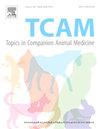胫骨近端截骨术治疗2例猫窒息的IV级内侧髌骨脱位。
IF 1.3
3区 农林科学
Q2 VETERINARY SCIENCES
引用次数: 0
摘要
目的:缺乏关于猫高度髌骨脱位的手术治疗的文献。其中,矫正截骨术适用于矫正严重的骨畸形。因此,本研究旨在报道两只猫通过胫骨矫正截骨术治疗IV级内侧髌骨脱位(MPL)的手术治疗。材料和方法:两只猫被诊断为IV级MPL。在x线和断层图像上观察到的明显改变显示胫骨外扭转15.7°和21.8°,同时胫骨外翻13.9°和胫骨平台角(TPA)分别为20°。对于手术治疗,病例1进行了椎体成形术,病例2进行了阻断滑车成形术,随后结合了最初为犬开发的技术。胫骨近端全截骨术(PTO)联合内侧新月形闭合楔形截骨术(MCCWO) 1例,颅骨闭合楔形截骨术(CCWO) 1例。结果:两只猫术后均获得满意的结果,膝关节伸肌机制复位,主观分析两胫骨扭转接近0°。此外,第一只猫的胫骨内侧近端机械角为91°,胫骨内侧远端机械角为99.3°,而第二只猫的TPA为9.2°。没有观察到严重的并发症,并且猫在患病肢体上显示出早期的负重恢复。结论:这两个病例都强调了胫骨矫正截骨术适用于猫,并可能在治疗高级别MPL的决策过程中发挥作用。此外,专利商标局与MCCWO或CCWO的结合可能有助于取得令人满意的结果。本文章由计算机程序翻译,如有差异,请以英文原文为准。
Proximal tibial osteotomies for treating grade IV medial patellar luxation in two feline stifles
Objectives
There is a lack of literature regarding the surgical management of high-grade patellar luxation in cats. Among the available options, corrective osteotomies are suitable for correcting severe bone deformities. Therefore, this study aimed to report on the surgical management of grade IV medial patellar luxation (MPL) through tibial corrective osteotomies in two cats.
Material and Methods
The two cats were diagnosed with grade IV MPL. The marked alterations observed in radiographic and tomographic images indicated external tibial torsion of 15.7° and 21.8°, concomitant with tibial valgus of 13.9° and a tibial plateau angle (TPA) of 20°, respectively. For surgical treatment, chrondoplasty was performed in Case 1, and block recession trochleoplasty in Case 2, followed by a combination of techniques originally developed for dogs. Proximal total tibial osteotomy (PTO) was combined with medial crescentic closing wedge osteotomy (MCCWO) for one case and with cranial closing wedge ostectomy (CCWO) for the other case.
Results
Satisfactory postoperative results were obtained for both cats, resulting in realignment of the stifle extensor mechanism, with both tibial torsions close to 0° in subjective analysis. Additionally, a mechanical medial proximal tibial angle of 91° and a mechanical medial distal tibial angle of 99.3° were achieved for the first cat, whereas a TPA of 9.2° was achieved for the second cat. No major complications were observed, and the cats showed an early return to weight-bearing on the affected limb.
Conclusion
Both cases highlight that tibial corrective osteotomies are suitable for cats and may play a role in the decision-making process for treating high-grade MPL. Moreover, a combination of PTO with MCCWO or CCWO may help achieve satisfactory outcomes.
求助全文
通过发布文献求助,成功后即可免费获取论文全文。
去求助
来源期刊

Topics in companion animal medicine
农林科学-兽医学
CiteScore
2.30
自引率
0.00%
发文量
60
审稿时长
88 days
期刊介绍:
Published quarterly, Topics in Companion Animal Medicine is a peer-reviewed veterinary scientific journal dedicated to providing practitioners with the most recent advances in companion animal medicine. The journal publishes high quality original clinical research focusing on important topics in companion animal medicine.
 求助内容:
求助内容: 应助结果提醒方式:
应助结果提醒方式:


